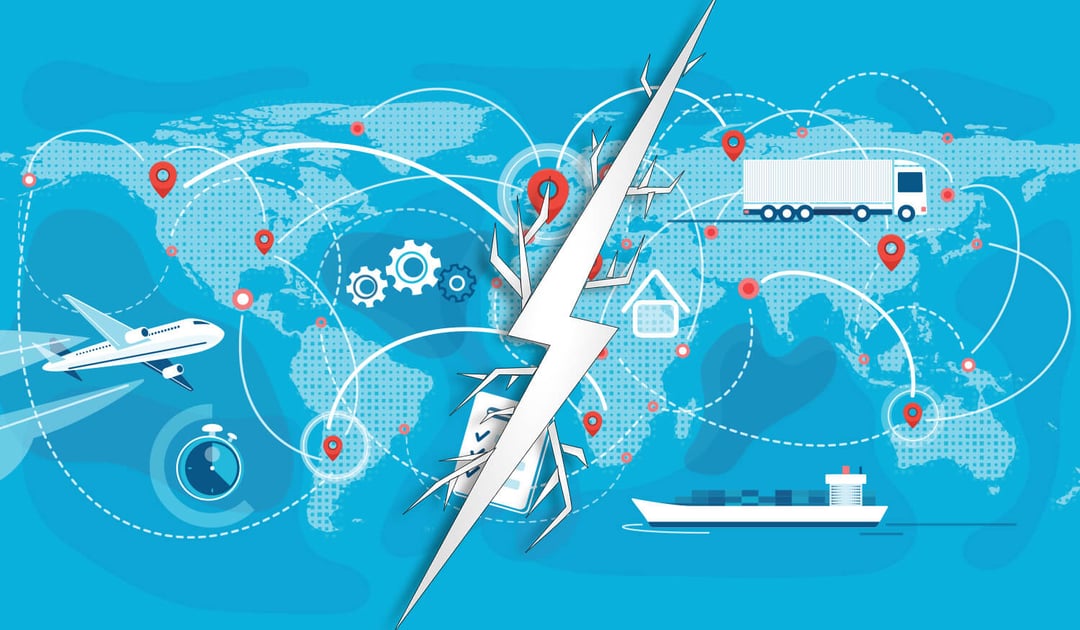
Executives and consumers had front row seats to the impact of global supply chain disruptions over 2020 - 2022. Because of material supply shortages and increases in prices, logistics professionals worked tirelessly trying to correct the problems.
While supply chain disruptions hit unprecedented levels during the pandemic, supply chain disruption examples continue today. After all, the pandemic was not the cause of the supply chain problems. Instead, the pandemic amplified and accelerated pre-existing issues within supply chains that were already occurring at levels that did not make front page news.
Though supply chain stress has dropped since the covid-19 pandemic peak, plenty of supply chain disruptors continue to threaten businesses. To help understand the problems we all experienced, let’s walk through the top ten supply chain disruption examples - in other words, the causes of supply chain disruption.
Why are supply chains still disrupted?
Globalization
With the rise of globalization, supply chains have become increasingly complex and interconnected. The result is disruptions in one part of the world can quickly spread to other regions, leading to widespread supply chain problems for a company - and beyond.
Just-in-Time Inventory
Just-in-time inventory practices keep low inventory levels on hand and rely on timely deliveries from suppliers. While this practice is cash friendly, it leaves companies vulnerable to disruptions in the supply chain. The best insurance in this case is properly forecasting needs and a strong vendor base that cares as much about supply chain resilience as your company.
Natural Disasters
Natural disasters such as hurricanes, earthquakes, polar vortexes, floods and fires have been increasing in frequency. Their effects disrupt freight networks by damaging infrastructure - leading to delays in transit or supply if the area hit is the source of raw material, manufacturing and/or distribution.
Political Instability
Political instability in one region can lead to changes in trade policies, border closures and other disruptions that can impact global supply chains. While political instability is more often considered an overseas issue, the aforementioned globalization and interconnectivity of supply chains now has far reaching effects well beyond where the turmoil occurs.
Labor Issues
Union contract negotiations cause disruptions in two ways: work slowdown or stoppage as labor discussions are in progress, and even strikes or lockouts if the labor talks break down. Supply chain leaders have contingencies to avoid labor issues like shuffling freight carriers used in their supply chain or avoiding regions of the country that could be impacted by a strike. But while the contingencies help, they are not long-term fixes for extended labor unrest.
Cyber Attacks
The increasing reliance on digital systems and the internet has made supply chains more vulnerable to cyber attacks. A cyber attack can affect transportation networks, communication channels and supply chain management systems, leading to significant disruptions in the movement of products.
Investment
Supply chains are not cheap and are not created overnight. They need infrastructure and technology to be globally competitive, which cannot be addressed with the flip of a switch. In other words, successful (and less vulnerable) supply chains require consistent investment. The vision of where to go needs to be addressed well before the problem can make a negative impact on a company, city, region or nation.
Keeping Up with the Data
The speed and amount of data companies collect has been growing faster than their ability to use the data in a meaningful way. The result is companies get behind and miss the trends, hence the big technology bets and AI work that are becoming increasingly prevalent in the supply chain space.
Balance
A critical facet of the freight and logistics companies moving freight is balance in their network. That means the balance between inbound freight heading to a region is somewhat equal to the outbound freight coming from the region. Without balance, there may be demand, but no supply of equipment - or vice-versa. The results of this imbalance are service issues and elevated freight rates.
There are always times in which the balance is off in a singular company network. But if imbalance becomes a regional, national or global issue, all are affected in a more significant way as it moves to impact larger regions. When that occurs, it takes a greater amount of time and resources to correct itself.
Time to Correct
Speaking of time, depending on the supply chain disruption it could take anywhere between days and years before the ultimate problem is cleared. The pandemic supply chain disruptions are an example of one that's fallen into the latter category.
While the issues are worked out in a supply chain, there is quite often a see-saw effect of good and bad results, as situations settle into place.
How to Handle Supply Chain Disruptions
Not all supply chain disruptions can be avoided. But with well-developed supply chain management strategies, companies can better handle when the next supply chain crisis threatens their business. The goal should be to lessen their impact so as to limit long-term damage to vendor, customer, employee and investor relationships.
If you're looking for help managing supply chain disruptions, let us know by filling out our brief Request a Quote form. We'll be happy to get back to you to discuss your unique needs. If you need more information about this or other freight topics, browse our Freight Guides for free eBooks and comprehensive articles, or check out more of our blog.
Get Updates
Featured Articles
Categories
- Freight & Shipping Costs (54)
- Freight Broker (60)
- Freight Forwarder (2)
- Intermodal Transportation (184)
- International & Cross Border Logistics (43)
- Logistics & Supply Chain (420)
- Logistics Service Provider (77)
- LTL (39)
- Managed TMS (49)
- News (39)
- Supply Chain Sustainability (12)
- Transportation Management System (37)
- Truckload (122)
- Warehousing & Distribution (50)



